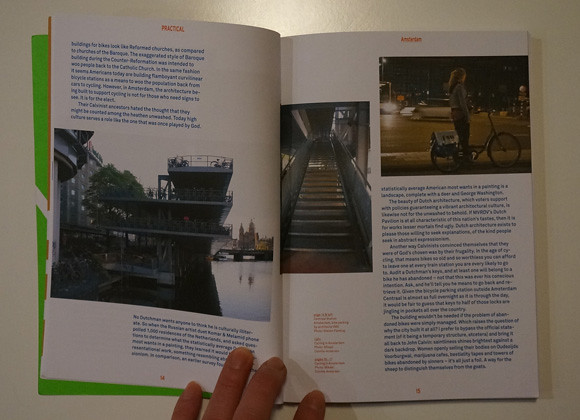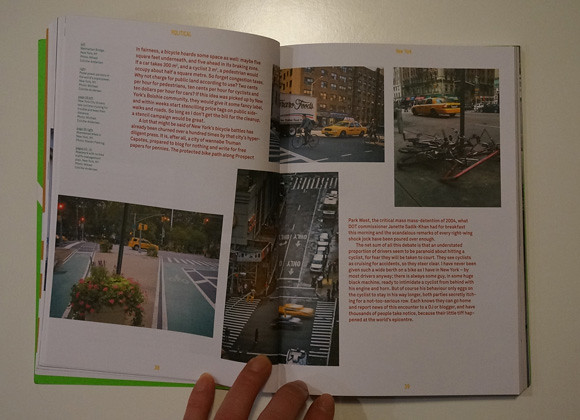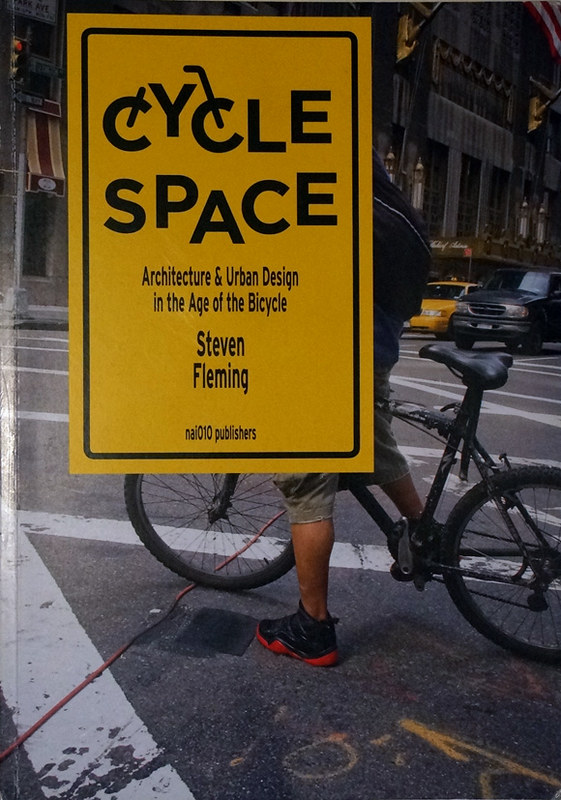
Book – Cycle Space
Cycle Space: Architecture and Urban Design in the Age of the Bicycle by Steven Fleming is a nai010 publishers book. It aims to takle the questions surounding the rebewed popularity of cycling in the urban areas of the western world from a architects point of view.
The book is cleverly organised in chapters mixing examples and theory. The author understands to weave experience and references to creat a dense fabric around the topic of cycling in our cities today.
In eight chapters the reader is taken on a tour around the world starting in Amsterdam, probably considered the ultimate cycling city, under the aspect of cycling is practical, to New York where cycling is reported as political, back to Copenhagen wher it is all about design, down to Sydney, where Cycling is prestigious, to Singapore for free cycling, to Portland where cycling is cool, to Chicago for green cycling to finally end in Paris the city of teatrical cycling.
This broad approach aims to creat an universal picture of cycling, locally working out the specifics to feed them into a discusiof cycling on a global level. Whilst it is a big strech the depth of the local examples is actually a large plus of this publication.
Cycling is a very direct and individual experince of the city and local knowledge is key to finding the suitable route. The author is from down under and knows his place inside out, but makes an efford to get to know all the places featuring in the book. Linking up with locals and drawing on their unique knowledge is key to a successfull portrait in the book. In this sense the reports are presented as well informed, packed with insider tips.
This on the other hand also renders the accounts very personal making them challenging to generalise in an objective sense urban planning discussions are usually held. However the topic might require the exploring of new territory regarding the synthesising of strategies for the development and implementation of ridable cities.

Image taken from the book / Sample spread of the book Cycle Space.
Overall it is a well structured book with clear insight both regarding first hand experience reports and theoretical background. The reader is being presented with interesting portraits. Although it is difficult to get into different environments if your not really living it, being a local is not easy, but with great support and advice workable. It provides an insightful discussion of the cycling topics both as actual challenges faced by planning and political authorities, theoretical with references to planing ideas such as modernism, but also current project recently being built for cycling.
Te author makes a clear case that planning for cycling clearly has to go beyond the integration of bike infrastructure in new and renewing projects in urban areas. However it has to be noted that it is not enough to just reduce it to brown fields. Very few cities in Europe for example have the concrete storm flood water ways the author preferably refers to as ideal sites for cycling.
Cycling is a networked based activity and as the author of the book remarks on different occasions mainly based on en-route, in-context decision making. Whilst cycling, similar to pedestrians, one craves for the freedom of choice and options. Variety, possibilities and flexibility is what makes cycling exciting and this is too perfectly portrayed by the author already in the introduction. In this context the call of the book for separated and specific, exclusive cycling infrastructure seems not quite fitting.
The bolder, and possibly cheaper call, would bee for shared infrastructure. After all at the crossroad we all meet and have to negotiate anyway. Why not work towards a slower city with room, acceptance and respects for all road users equally? Probably because it is a learning curve, in most of the portrait cities a steep and tough one, but arguably the sustainable long term goal. It could be argued that isolating one selves as cyclists to exclusively cycling infrastructure is not only something cities like NY, London or HK simply can’t possibly achieve in a reasonable and useful timeframe, is way too costly as it means parallel, hence double costing, but will not necessarily evolve towards better understanding of users of the same road space.

Image taken from the book / Sample spread of the book Cycle Space.
Progress as such can not just be pushed towards the urban planners as their responsibility. It is a mindset that has to be embedded in society as a concept to be backed by acceptance and become everyday practice. Politics and general believes have to grow accustomed to the idea of cycling. In London for example one of the big problems beside a lack of space is the fact that every body else on the street,including pedestrians do not expect or consider cyclists. They are still alien to the idea of other road users might be cycling. This is not something urban planners can change, it needs a collective effort to establish cyclists in all areas as equal road users.
To sum up the discussion, this is a book not short on personal statements, creating occasional controversies, which makes it a very interesting read. The topic is definitely timely and most of the major cities are currently evaluating their cycle infrastructure. By giving such a broad overview covering different locations the book has something for everyone. It can not be taken as a manual but a valuable contribution to the still itself organising discussion on the state of cycling and the possible reactions to it of the urban environment.

Image taken from the book / Book front cover.
Fleming, S., 2012. Cycle Space – Architectural and Urban Design in the Age of the Bicycle, NAI010 Publishers.
